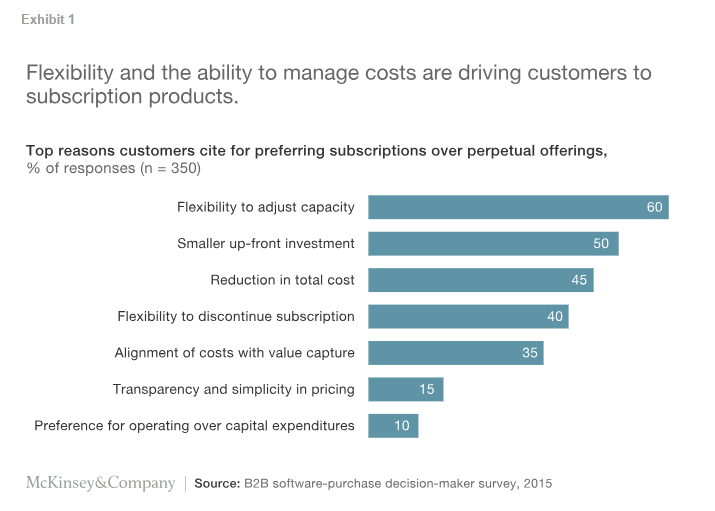“By 2020, all new entrants and 80% of historical vendors will offer subscription-based business models, regardless of where the software resides. What began as a trickle a few years ago has become a stampede of vendors wanting to make a move to a subscription business model.”
This statistic from research firm Gartner forecasts the subscription business model as not just an option, but a necessity when considering the acquisition and retention of customers, and ultimately the long-haul growth of your business.
For customers seeking physical goods like Birchbox, Dollar Shave Club or Stitch Fix, or digital goods like content streaming or software-as-a-service, the subscription business model makes significant sense in terms of price, value and security, and continues to power a sea change in the way companies do business and consumers make purchase decisions.
Pricing Suits the End User
Whether a single consumer or a business-to-business decision maker, significant investment and upfront cost tends to connote risk without assured value. The perpetual model requires a monetary and/or contractual commitment upfront without the complete knowledge that the service meets personal needs or the needs of your business. This can cause any number of frustrations for the end user.
A benefit of the subscription model is that it requires a much softer commitment, where the month-to-month experience with the software enables a trial-and-error approach to see what works best for the end user’s needs, without the full upfront cost. From here, the customer can change providers if necessary, or adapt the functions and features of the service with their current provider based on their particular needs.
See the McKinsey & Co. data below indicating the top factors driving consumers to a subscription purchase versus a perpetual offering.
Software Feature Updates and Cyber Security
Quality software maintains a consistent schedule of updates, new versions, bug fixes, etc., but the perpetual license model often places the burden of responsibility on the end user to take the time and effort to trigger those updates. The subscription model enables the software provider to support an update schedule automatically – not to mention deploying new features when they’re ready, not just when the new version is available – ensuring the end user has the best possible customer experience.
And what’s more important than the customer experience? The security of customer data. Cyber attacks represent a significant threat to ecommerce companies, retailers, and just about anyone who’s used a credit card or operated a computer or smartphone.
According to internet software and service provider Protected Trust, operating outdated software is one of the most significant factors enabling criminals to access and exploit customers’ private information, second only to phishing scams. Ensuring your customers are operating up-to-date software gives them the necessary defense to minimize that risk.
Collaborate with Ease with Cloud Storage
The pace of business is moving faster than ever. In turn, a company’s software suite should accommodate the speed of its operations.
One of the key benefits of the subscription model is that it easily supports cloud storage, which offers a level of convenience and flexibility not previously seen with the perpetual license model.
For example, the difference between Microsoft Office 2016 and Microsoft Office 365 is that the 365 offering is connected to Microsoft’s cloud storage system. Therefore, in addition to having access to the full Microsoft office suite, the cloud-based offering supports easier file sharing, group chats, video hosting and screen shares – among many other features – and can be used anywhere in the world.
Keystone
There are a wide variety of reasons to move from perpetual to subscription, both from the company and customer points of view. As a software company, the opportunities for customer personalization, richer communication and revenue retention are vast.
And for the customer or B2B buyer, customization, ease of updates and improvements and low upfront cost makes significant sense when implementing software for personal or professional use. It’s no surprise the market continues its steadfast march toward the subscription billing business model.
Read more about subscription billing in some previous blog posts:
- Subscription Billing Models Defined
- Evaluating Commerce Solutions: Billing and Payment Tools
- Evaluating Commerce Solutions: Subscription Management Tools
cleverbridge can optimize recurring billing, streamline global payment processing and help your company scale globally. Contact us today to learn more.
Kyle Shamorian is the content marketer for cleverbridge.

